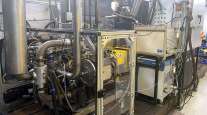Staff Reporter
Run on Less Event Sees Big Improvements, Pleasant Surprises

[Stay on top of transportation news: Get TTNews in your inbox.]
The North American Council for Freight Efficiency’s latest Run on Less program is largely producing pleasant surprises so far, including Tesla Semi performance that lives up to more than a little of the hype of recent years, according to the study group.
There have been big improvements in trucks and chargers since Run on Less–Electric in 2021, NACFE said in a series of posts on the early lessons learned from Run on Less–Electric Depot, which started Sept. 11 and runs through Sept. 30.
“The electrification of large depots is more realistic than we originally thought,” NACFE Executive Director Mike Roeth said in a statement: “Electric trucks are becoming an option in longer regional haul return-to-base operations.”
Tesla Semis surprised Roeth and Dave Mullaney, who works at NACFE partner RMI, with their performance, but other Class 8 tractors are demonstrating range double that of the trucks that took part in the 2021 event.
Shippers and Zero Emissions from NACFE on Vimeo.
In particular, there is better efficiency, including optimizing regenerative braking and return-to-base charging during single driver shifts, NACFE said. This has occurred consistently at OK Produce, Penske, Performance Team, PepsiCo and Schneider.
PepsiCo ranks No. 1 on the Transport Topics Top 100 list of the largest private companies in North America. Schneider ranks No. 8 on the TT100 list of the largest for-hire carriers. Penske ranks No. 21 on the TT100 list of the largest logistics companies.
A total of 10 depots are involved in the program as NACFE investigates what it takes to scale up from one or two electric trucks to 15 or more.

Tesla Semis with PepsiCo brands' logos. (Mike Roeth/NACFE)
The Tesla Semis at PepsiCo Inc.’s Sacramento Beverages depot completed 384 miles on a single charge and 806 miles in a single 24-hour day, enabled by fast 750 kilowatt charging.
“The Tesla Semis are showing us what fast charging can do,” Roeth told attendees of a Sept. 18 LinkedIn Live event.
Tesla Inc. CEO Elon Musk promised a range of 500 miles without charging with a full 80,000-pound gross vehicle weight when launching the Semi in 2017.
“The Tesla numbers speak for themselves. They are showing us sort of the future. It’s like the art of the probable here, we hear art of the possible, well, this is more the art of the probable, because it is real trucks, real freight,” Roeth said, so that longer regional haul options open up.
Another big question in fleet electrification was always whether the trucks were viable in high-uptime, slip-seat applications, where multiple drivers drive the same truck one after the other, said Mullaney, carbon-free transportation principal at RMI, adding that he too was skeptical for the longest time.
Join us TODAY, 9/18 at 1 pm ET as we present #RunOnLess — Electric DEPOT Mid-Run Results, including many of the issues that have become clear given the efforts of the Run. @RockyMtnInst @PepsiCo @Cummins @Shell_USA #ElectricDepots #ElectricTrucks https://t.co/6nBQCIAT6p pic.twitter.com/k0fHREB162 — RunOnLess (@RunOnLess) September 18, 2023
“The fear was always that we’d need more trucks to do the same job in high-uptime situations, adding cost to the system,” he said in a LinkedIn post.
“I was also skeptical. Not anymore,” he said. “The combination of megawatt level charging and battery packs that are probably close to a megawatt-hour (this number is not officially disclosed) clearly can do the job.”
One PepsiCo Tesla Semi traveled 1,600 miles in a little less than 48 hours, he said.
Mullaney also detailed how a Freightliner eCascadia out of a US Foods Inc. depot shows a different type of potential — both in how much charge is needed and in supporting the grid in California, where seven of the eight fleets are operating. The truck would exit the depot at around 3:30 a.m. and carry out a multistop route, returning at about 4:30 p.m.
“That’s a full day’s work for the driver, but the truck isn’t tired at all. In fact, it’s 60%-70% SOC represents 285-330 kWh of unused power,” Mullaney wrote. “Getting back at 4:30 p.m. is interesting though, because that is just about when solar generation starts to fade, and the ramp of California’s famous duck curve starts to kick in.”
“No operator is going to run down their batteries to zero, so not all of that 300ish kWh are going to be available, but 200 [kilowatt hours] might be if the price was right. These truck batteries are big, and they are being operated by sophisticated companies using sophisticated chargers, which makes for a real opportunity for [vehicle to grid],” he added.

Freightliner eCascadias at a US Foods Inc. depot. (NACFE via Vimeo)
Freightliner’s eCascadias also shone in intermodal drayage operating out of Schneider Inc.’s South El Monte depot, said Mullaney, detailing a 13-hour shift where the truck was engaged in stop-and-go driving for the whole time.
“This type of duty cycle is where electrics can really shine. This one completed a 185-mile day, with no opportunity charging (and no down time to charge if it had needed it), in stop-and-go conditions,” he wrote, adding: “This type of duty cycle is where traditional diesels fare the worst, both in terms of fuel economy and pollution emissions — with emissions management systems often struggling in low engine load conditions like this.“
NACFE expects to be able to share more data on the program, and in particular about the payloads for the trucks, in a report due to be issued in October, said Roeth.
Want more news? Listen to today's daily briefing below or go here for more info:




